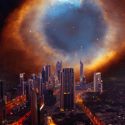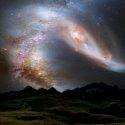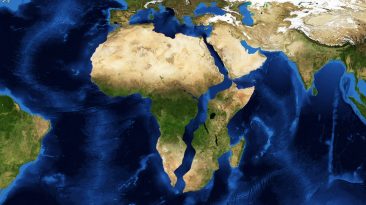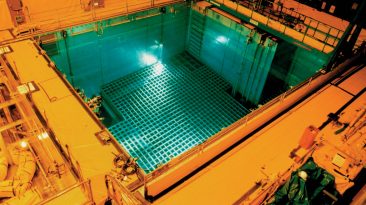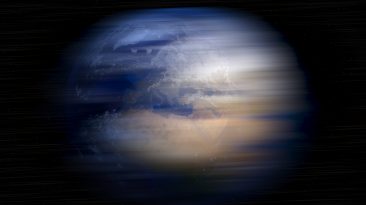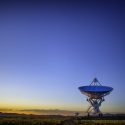Stars with a much larger mass than our Sun burn out after just a few million years; in a gigantic explosion known as a supernova.
Moving at the speed of light, millions of tons of plasma, neutrinos and a whole lot of light are ejected from this explosion. But there’s something left behind.
What exactly is this thing? And what would happen if our Sun was one of them?
A neutron star is one of the strangest things in our universe. Its dimensions are pretty crazy but bear with us.
The star is only 20km (13 miles)across. That’s smaller than most cities!
Not only that but the sheer density of this relatively tiny star is also bizarre. A single cubic centimeter of a neutron star weighs 400 million tons.
But what exactly does that mean? To put it in perspective imagine every single vehicle in the United States being crushed up into just a single sugar cube.
Now imagine millions of those coming together, and that’s a neutron star. With dimensions like this, there would be some pretty significant implications for us if our Sun was suddenly replaced by one.
[dx_custom_adunit desktop_id=”RTK_CDE4″ mobile_id=”RTK_SUFd”]Let’s get this straight. Our Sun will never become a neutron star. Why?
Because neutron stars are born from suns that are 10-20 times the size of ours. In 5 billion years our Sun will become a red giant and then eventually a cold white dwarf which is similar to a neutron star, just much larger and much less dense.
But forget about all that, this is WHAT IF after all. A neutron star replacing our Sun would be pretty dangerous, to say the least.
A neutron star’s gravitational force would be 2 billion times stronger than Earth’s. This means that pretty quickly, every single planet in our solar system would be pulled towards the star and be destroyed.
And it wouldn’t stop there. A neutron star rotates incredibly fast, over 700 times every second whereas our Sun rotates once every 27 days or so.
This means the star would be whirling throughout space at one-fifth of the speed of light. After thousands of years, many neutron stars begin to slow down and fizzle out. But that doesn’t always happen.
Sometimes a neutron star meets another star. The neutron star will begin to orbit the fully formed sun, and will start to feed off its atmosphere until it eventually collapses in on itself and becomes a black hole.
If you happened to be in another galaxy at the time, you’d see the neutron star as a flashing light, also known as a pulsar. Discovered in 1967 by astrophysicist Jocelyn Bell, pulsars are caused by a neutron star’s magnetic field. Which, no surprise, is incredibly strong.
But let’s hope this neutron star isn’t a magnetar. What’s a magnetar you ask? It’s an even stronger and rare type of neutron star. A neutron star ‘s magnetic field may be incredibly strong, but a magnetar’s magnetic field is 1,000 times more powerful. Yeah, we weren’t kidding about these numbers being a little ridiculous.
The crust of this star is under a massive amount of strain. If it happens to move at all, it creates a starquake.
Yes, this may be a super cool sounding word but don’t let that fool you. These things are scary.
The crust of the star would erupt in a massive explosion, causing its magnetic field to react. This would create a massive solar storm that travels across the entire galaxy.
And it wouldn’t just be any solar storm. It would be trillions of times stronger than anything the Sun could produce.
Subscribe to What-If on Youtube or follow the show on Facebook Watch.
Sources
- “What Happens If the Sun Replaced by a Neutron Star” 2019. steemit.com. Accessed February 12 2019.
- “What If The Sun Became A Neutron Star? – Quora”. 2019. quora.com. Accessed February 12 2019.
- “The Weight And Workings Of A Neutron Star:”. 2019. Futurism. Accessed February 12 2019.
- “The Life Cycle Of A Neutron Star – David Lunney”. 2019. TED-Ed. Accessed February 12 2019.
- “What Is A Neutron Star?”. 2019. Youtube. Accessed February 12 2019.
- “Neutron Stars: Definition & Facts”. Redd, Nola. 2018. space.com. Accessed February 12 2019.
- “Neutron Stars: Crash Course Astronomy #32”. 2019. Youtube. Accessed February 12 2019.
- “Star Facts: The Basics Of Star Names And Stellar Evolution”. Choi, Charles. 2017. space.com. Accessed February 12 2019.
- “What Happens When An Enormous Star Blows Up?”. 2019. Sciencedaily. Accessed February 12 2019.
- “How The Sun’s Magnetic Field Works (Infographic)”. Tate, Karl. 2013. space.com. Accessed February 12 2019.






